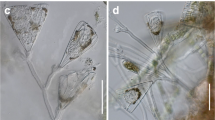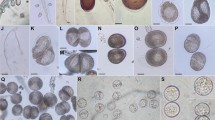Abstract
Despite their widespread nature and economic impact, little is known regarding the diversity and phylogeny of diatom-infecting oomycetes. While the phylogenetic affinities of Lagenisma, affecting large centric diatoms, has recently been resolved, no member of the widespread genus Ectrogella has, so far, been investigated using molecular phylogenetics. The genus Ectrogella contains about a dozen species, which are all holocarpic. The species in the genus are diverse in terms of morphology and development, and primarily set apart from other holocarpic oomycete genera on the basis of their occurrence in unicellular or colonial algae, predominantly licmophoroid and bacillarioid diatoms. Here, we report the phylogenetic placement of two oomycete parasitoids one parasitic to Pseudo-nitzschia pungens and the other parasitic to Rhizosolenia imbricata. While both parasitoids were placed outside the crown oomycete groups represented by Saprolegniomycetes and Peronosporomycetes, they did not form a monophyletic assemblage. The Rhizosolenia parasitoid was embedded amongst marine Olpidiopsis species, while the Pseudo-nitzschia parasitoid was placed as the sister clade to all remaining oomycetes. The taxonomy of Ectrogella-like organisms and Olpidiopsis is discussed and, as a consequence of morphological differences and phylogenetic placement, two new species, Miracula helgolandica and Olpidiopsis drebesii, are introduced.



Similar content being viewed by others
References
Aleem AA (1953) Marine fungi from the west-coast of Sweden. Ark Bot 3:1–33
Bates SS, Trainer VL (2006) The ecology of harmful diatoms. In: Granéli E, Turner JT (eds) Ecology of harmful algae. Springer Verlag, Heidelberg, pp 81–93
Bates SS, Garrison DL, Horner RA (1998) Bloom dynamics and physiology of domoic-acid-producing Pseudo-nitzschia species. In: Anderson DM, Cembella AD, Hallegraeff GM (eds) Physiological ecology of harmful algal blooms. Springer Verlag, Heidelberg, pp 267–292
Beakes GW, Sekimoto S (2009) The evolutionary phylogeny of Oomycetes—insights gained from studies of holocarpic parasites of algae and invertebrates. In: Lamour K, Kamoun S (eds) Oomycete genetics and genomics: diversity, interactions, and research tools. John Wiley & Sons, Hoboken, NY, pp 1–24
Beakes GW, Thines M (2017) Hyphochytriomycota and Oomycota. In: Archibald JM, Simpson AGB, Slamovits CH (eds) Handbook of the Protists. Springer Verlag, Heidelberg, pp 435–505
Beakes GW, Honda D, Thines M (2014) Systematics of the Straminipila: Labyrinthulomycota, Hyphochytriomycota, and Oomycota. In: McLaughlin DJ, Spatafora J (eds) The mycota, vol. VIIA. Fungal taxonomy and systematics. Springer Verlag, Berlin, Heidelberg, pp 39–97
Braun A (1856) Über Chytridium, eine Gattung einzelliger Schmarotzergewächse auf Algen und Infusorien. Abh Königl Akad Wiss Berlin 1855:21–83
Dick MW (2001) Straminipilous fungi: systematics of the Peronosporomycetes including accounts of the marine straminipilous protists, the plasmodiophorids and similar organisms. Kluwer Academic Publishers, Dordrecht
Drebes G (1968) Lagenisma coscinodisci gen. nov., spec. nov., ein Vertreter der Lagenidiales in der marinen Diatomee Coscinodiscus. Veröff Inst Meeresf Bremerhaven Sbd 3:67–70
Edgcomb VP, Kysela DT, Teske A, de Vera Gomez A, Sogin ML (2002) Benthic eukaryotic diversity in the Guaymas Basin hydrothermal vent environment. Proc Natl Acad Sci U S A 99:7658–7662
Edgcomb V, Orsi W, Taylor GT, Vdacny P, Taylor C, Suarez P, Epstein S (2011) Accessing marine protists from the anoxic Cariaco Basin. ISME J 5:1237–1241
Feldmann J, Feldmann G (1955) Observations sur quelques Phycomycetes marins nouveaux ou peu connus. Rev Mycol 22:231–251
Friedmann I (1952) Über neue und wenig bekannte auf Diatomeen parasitierende Phycomyceten. Öst Bot Zeitschr 99:173–219
Hakariya M, Hirose D, Tokumasu S (2007) A molecular phylogeny of Haptoglossa species, terrestrial Peronosporomycetes (oomycetes) endoparasitic on nematodes. Mycoscience 48:169–175
Hanic LA, Sekimoto S, Bates SS (2009) Oomycete and chytrid infections of the marine diatom Pseudo-nitzschia pungens (Bacillariophyceae) from Prince Edward Island, Canada. Can J Bot 87:1096–1105
Johnson TW (1965) Chytridiomycetes and oomycetes in marine phytoplankton. Nova Hedwigia 10:579–588
Johnson TW (1967) Monocentric fungi on species of Rhizosolenia from saline habitats. Mycopathol Mycol Appl 32:281–290
Karling JS (1942) The simple holocarpic biflagellate Phycomycetes. Published by the author, JS Karling, New York
Katoh K, Standley DM (2013) MAFFT multiple sequence alignment software version 7: improvements in performance and usability. Mol Biol Evol 30:772–780
Kok SP, Kikuchi T, Toda T, Kurosawa N (2012) Diversity and community dynamics of protistan microplankton in Sagami Bay revealed by 18S rRNA gene clone analysis. Plankton Benthos Res 7:75–86
Kraberg AC, Carstens K, Peters S, Tilly K, Wiltshire KH (2012) The diatom Mediopyxis helysia Kühn, Hargreaves & Halliger 2006 at Helgoland roads: a success story? Helgol Mar Res 66:463–468
Massana R, Castresana J, Balagué V, Guillou L, Romari K, Groisillier A, Valentin K, Pedrós-Alió C (2004) Phylogenetic and ecological analysis of novel marine stramenopiles. Appl Env Microbiol 70:3528–3534
Medlin LK, Metfies K, Mehl H, Wiltshire K, Valentin K (2006) Picoeukaryotic plankton diversity at the Helgoland time series site as assessed by three molecular methods. Microbial Ecol 52:53–71
Pauley KE, Fritz L, Strongman D, O’Neil D, Smith JC (1994) Parasitism of Pseudo-nitzschia pungens by a marine fungus. In: Forbes JR (ed) Proceedings of the 4th Canadian Workshop on Harmful Marine Algae. Canadian Technical Report of Fisheries and Aquatic Sciences 2016, 28
Petersen HE (1905) Contributions á la connaissance des phycomycètes marins (Chytridinae Fischer). Det Kongelige Danske Videnskabernes Selskab 5:439–488
Raghu kumar C (1980) An ultrastructural study of the marine diatom Licmophora hyalina and its parasite Ectrogella perforans. I. Infection of host cells. Can J Bot 58:1280–1290
Raghukumar C (1978) Physiology of infection of the marine diatom Licmophora by the fungus Ectrogella perforans. Veröff Inst Meeresf Bremerhaven 17:1–14
Raghukumar S (2017) The pelagic ecosystem. In: Rhagukumar S (ed) Fungi in coastal and oceanic marine ecosystems. Springer Verlag, Heidelberg, pp 185–217
Scherffel A (1925) Endophytische Phycomyceten-Parasiten der Bacillariaceen und einige neue Monadinen. Ein beitrag zur Phylogenie der Oomyceten (Schröter). Arch Protistenkd 52:1–141
Schnepf E, Deichgräber G, Drebes G (1978) Development and ultrastructure of the marine, parasitic oomycete, Lagenisma coscinodisci Drebes (Lagenidiales). Arch Mikrobiol 116:133–139
Scholz B, Guillou L, Marano AV, Neuhauser S, Sullivan BK, Karsten U, Küpper FC, Gleason FH (2016a) Zoosporic parasites infecting marine diatoms—a black box that needs to be opened. Fungal Ecol 19:59–76
Scholz B, Küpper FC, Vyverman W, Karsten U (2016b) Effects of eukaryotic pathogens (Chytridiomycota and Oomycota) on marine benthic diatom communities in the Solthörn tidal flat (southern North Sea, Germany). Eur J Phycol 51:253–269
Sekimoto S, Klochkova TA, West JA, Beakes GW, Honda D (2009) Olpidiopsis bostrychiae sp. nov.: an endoparasitic oomycete that infects Bostrychia and other red algae (Rhodophyta). Phycologia 48:460–472
Sparrow FK Jr (1933) Inoperculate chytridiaceous organisms collected in the vicinity of Ithaca, N. Y., with notes on other aquatic fungi. Mycologia 25:513–535
Sparrow FK Jr (1934) Observations on marine Phycomycetes collected in Denmark. Dansk Bot Ark 8(6):1–24
Sparrow FK Jr (1936) A contribution to our knowledge of the aquatic Phycomycetes of great Britain. Bot J Linn Soc 50:417–478
Sparrow FK Jr (1960) Aquatic Phycomycetes, 2nd edn. The University of Michigan Press, Ann Arbor, Michigan
Strittmatter M, Gachon CM, Küpper FC (2009) Ecology of lower oomycetes. In: Lamour K, Kamoun S (eds) Oomycete genetics and genomics: diversity, interactions, and research tools. John Wiley & Sons, Hoboken, NY, pp 25–46
Tamura K, Peterson D, Peterson N, Stecher G, Nei M, Kumar S (2011) MEGA5: molecular evolutionary genetics analysis using maximum likelihood, evolutionary distance, and maximum parsimony methods. Mol Biol Evol 28:2731–2739
Thines M (2014) Phylogeny and evolution of plant pathogenic oomycetes—a global overview. Eur J Plant Pathol 138:431–447
Thines M, Nam B, Nigrelli L, Beakes G, Kraberg A (2015) The diatom parasite Lagenisma coscinodisci (Lagenismatales, Oomycota) is an early diverging lineage of the Saprolegniomycetes. Mycol Prog 14:75
Wang Y, Tian RM, Gao ZM, Bougouffa S, Qian PY (2014) Optimal eukaryotic 18S and universal 16S/18S ribosomal RNA primers and their application in a study of symbiosis. PLoS One 9:e90053
Wiltshire KH, Kraberg A, Bartsch I, Boersma M, Franke HD, Freund J, Gebühr C, Gerdts G, Stockmann K, Wichels A (2010) Helgoland roads, North Sea: 45 years of change. Estuar Coast 33:295–310
Zopf W (1884) Zur Kenntniss der Phycomyceten I. Zur morphologie und Biologie der Ancylisteen und Chytridiaceen, Zurgeich ein Beitrag zur Phytopathologie. Nova Acta Kaiserli Leopold-carolin Akad Naturf 46:141–236
Acknowledgements
The authors wish to thank Vincent Adams, Neil McNair, Dale Small, Don Beattie, Daniel McPhee, John White and Ewen Todd from PEI mussel toxin research for their help with diatom collections from Canada and toxicity testing, and staff at AWI for providing phytoplankton samples from Helgoland. Gordon Beakes is gratefully acknowledged for discussions on holocarpic oomycetes. Funding by the LOEWE in the framework of the Biodiversity and Climate Research Centre and the Cluster for Integrative Fungal Research is gratefully acknowledged. AB would like to thank Katholischer Akademischer Ausländer-Dienst (KAAD) for providing a three-year PhD scholarship. We are grateful for the constructive comments from the two anonymous reviewers that helped to improve the manuscript, and excellent typesetting service. MT is a section editor of Mycological Progress.
Author information
Authors and Affiliations
Contributions
MT, LH and AK conceived the study; AB, BN, LN and SP screened plankton samples, isolated infected diatoms and carried out PCR assays; AB and AK performed light microscopy; AB, AK, SP and MT analysed the data; MT, AB and SP wrote the manuscript, with contributions from the other authors.
Corresponding author
Additional information
Section Editor: Marc Stadler
Rights and permissions
About this article
Cite this article
Buaya, A.T., Ploch, S., Hanic, L. et al. Phylogeny of Miracula helgolandica gen. et sp. nov. and Olpidiopsis drebesii sp. nov., two basal oomycete parasitoids of marine diatoms, with notes on the taxonomy of Ectrogella-like species. Mycol Progress 16, 1041–1050 (2017). https://doi.org/10.1007/s11557-017-1345-6
Received:
Revised:
Accepted:
Published:
Issue Date:
DOI: https://doi.org/10.1007/s11557-017-1345-6




